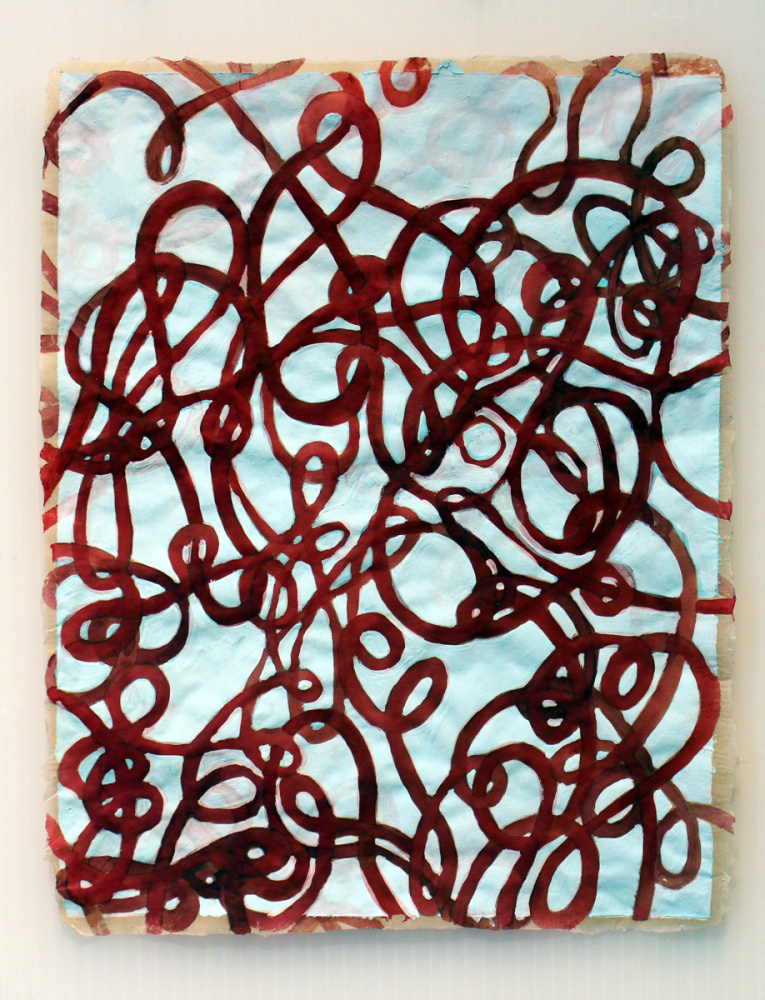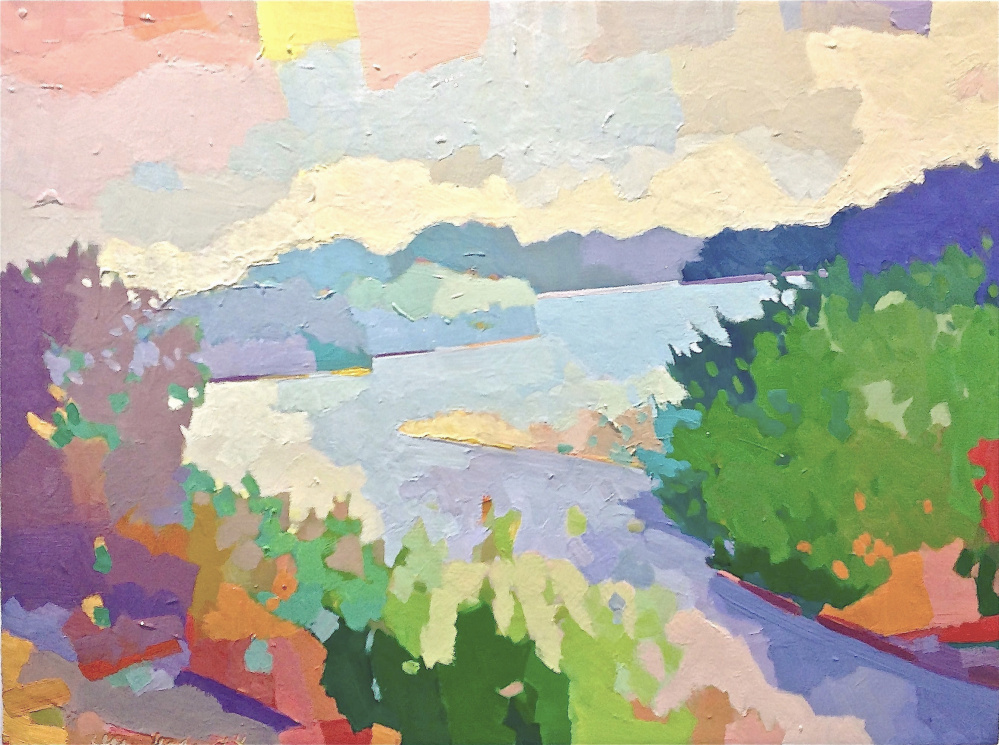Ron and Christine Spinella opened 3Fish Gallery in 1997. This month, during First Friday Art Walk in Portland, they hosted a closing party at their Cumberland Avenue space, easily identifiable because of the big-lettered phrase just below the large gallery window: “Art is eternal, Life is brief.”
The closing-show works looked heavily to the group of artists that make up the Addison Woolley collective, led by Susan Porter, but they were joined by 20 other area artists who have shown with the Spinellas. There were excellent works by Dianne Hudson, Dave Wade, Dan Dow, Jan Pieter van Voorst van Beest, Ruth Sylmor and many others, but I was particularly struck by the elegantly snaking red line arabesque gouache on flax by Cindy Davis and a surreal drawing by the inescapably fun Alex Rheault. Rheault’s red brush drawing includes a triple baby-headed tree, a splatter-tailed redbird, a heavenly wingtip and a chunk of meat that, due to a nearby leg prosthesis, looks like a section of human thigh. Rheault’s work is more playful than gory, however, and it dares the viewer to make what they will out of the uncanny cavalcade. It is, in other words, what the viewer chooses to make of it.
And that is true of 3Fish as well – the gallery as it was, as well as its closing. I heard many opinions during the farewell party ranging from sadness at the closing of another Portland gallery to the wider idea that 19 years is a good run for a gallery: We cannot, after all, unsee the art the Spinellas displayed.
Another weekend closing ceremony with a more obviously positive legacy was Peggy Golden’s retirement party just a day after the 3Fish First Friday event. Golden opened her shop in 1977 as Posters Plus, and it grew into Greenhut Galleries. She leaves Greenhut Galleries and its top-shelf roster of artists in the hands of new owners and a seasoned, professional and eminently able art staff. Over 40 years, Golden refined her gallery into of one of New England’s best, but with so many of Portland’s leading galleries closing (June Fitzpatrick, for example, retired in August) and a booming scene in Rockland, Greenhut has more possibilities and potential than ever.
And what we see in Greenhut’s holiday show is testament to a robust roster and a healthy gallery scene. We see a painter like Henry Isaacs as a new artist for Greenhut but at a big moment in his career, when he is becoming one of the best known and most popular painters in Maine. The same can be said of Ken Greenleaf, whose rhythmically unfurling geometrically shaped canvas abstraction, “Perdido,” is unlike anything else at the gallery. Greenleaf is finding another major moment in the New York spotlight (he made his mark as a sculptor in the ’70s) just now as he is new to Greenhut. Knowing I can now always see their work on view at Greenhut will bring me back again and again.
And then there are the big, broad names who lead the way, like David Driskell, Jon Imber, Robert Hamilton, Maurice Freedman, Alan Magee (whose large tapestry of paint tubes is a beautiful thing indeed) and the extraordinary John Whalley. To a certain extent, my interest in their work has taken ink away from other Greenhut artists – who often headline other galleries. Joel Babb’s light-dappled Spring Street scene of the McClellan and Clapp houses, for example, is a gem of a high-focus, old-school oil painting. Tom Connelly’s quiet library is one of the few available paintings he has now. (Things are going well for him.) George Lloyd’s big, bold and inky still life with dirty dishes is a cheeky chunk of fun. Nancy Morgan Barnes’ “Snow Place” is a crafty panorama, an unseen scene of deer stepping away from a plow clearing a night road. Also fresh to Greenhut, Matt Blackwell’s BBQ canoe is a hilarious mess of a painting featuring a hilarious mess of a boater. Glenn Renell’s elegant presence in this show is led by his black and white acrylic landscape drawings – they’re like excellent lithographs, but more present. Sarah Knock’s “End of Pettingill Island” is a dense and chewy landscape that moves from chalky, slate blue skies to night-moist lush-darkened greens: It’s like a well-plated meal. Witty, but with a worthy flash of well-earned anger, Tom Paiment’s mixed-media paintings pop with a profane profundity appropriate to the American political moment.
And I could go on: Roy Germon and Colin Page are two of the most promising Maine painters, and they’re only mentioned here as an afterthought. The broad point is that Greenhut is more interesting, has more depth and is more relevant than ever.
The finer point, however, is that it’s easy to be cynical, and we guard against that. Many galleries have closed recently as several of Maine’s Portland-based art leaders have moved on. These are fixed points and we know them, so of course we feel their fresh absence. But more galleries are opening than closing. More spaces are expanding than constricting. It’s easy to look to Rockland and feel like the art heart of Maine is shifting north, but new venues are opening in Portland all the time. If you just sit back, it’s hard not to be cynical, but if you hit the streets and find your own way, there is much to be seen that is fresh and worthy.
Freelance writer Daniel Kany is an art historian who lives in Cumberland. He can be contacted at dankany@gmail.com.
Send questions/comments to the editors.









Comments are no longer available on this story